2012 Arctic Cat XF1100 Turbo Sno Pro vs. 2012 Arctic Cat XF800 Sno Pro
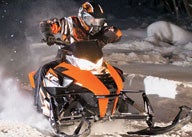
How do you like your power? Blown or two-stroked?
Choosing a performance Arctic Cat stretch track is serious business. The easy part comes in knowing that whichever 2012 Arctic Cat XF version you choose will come with the all-new Procross chassis, the uniquely tall dual A-arm Arctic race suspension and an aggressive 141-inch long single ply Cobra track. The hard part is deciding on your power package. Should you go full blown horsepower or lighter weight two-stroke?
The good news is that either 2012 Arctic Cat XF stretch track model is fundamentally the same everywhere but at the throttle. And there will be a weight difference as you can expect the twin cylinder turbo package to carry a bit more heft over the skis than the two-stroker. Still, the way Arctic Cat engineering designed the front suspension and steering cleverly disguises the four-strokers added poundage, leaving you with as easy handling of a four-stroke sport sled as you’ll find for 2012. Only the power-assisted steering of Yamaha’s Apex and Vector will be lighter.
The Basic Chassis
Each of these 2012 Cats get the extremely poised Procross stretch chassis with the lengthened FasTrack parallel rail rear suspension and Arctic Race Suspension front A-arm treatment. The sled has a unique look that leaves no doubt that this is the latest Arctic Cat and that you are riding something quite unique for 2012.
All that aside, the Procross stretch XF models gain the ability to handle groomed trails with added length to bridge those niggling stutter bumps and an added length of track patch to grip the corners under acceleration. Since the sled gains a bit of length with its 15-inch by 141-inch Cobra track (versus the F series 128-inch long track), Arctic Cat engineering added some off-trail, powder sled-derived features, like the mountain handlebar complete with rubber strap. The standard riser bar allows you to easily adjust your riding position to attack big bumps or maneuver through deeper snow off trail.
We found the new XF and its Procross chassis to be undeniably light and quick. Credit the engineers with creating a nimble sled that seems to read your “wants” almost before you know what you want. The single bell crank steering reflects a desire to “keep it simple.” There are fewer parts and the use of ball joints enhances the steering for precision and tight turning. These are things that highlighted the Sno Pro 600. While the front suspension design appears quite different when compared to the shorter arm A-arm designs of competitive sleds, the taller spindles and seemingly unencumbered design permit the use of lighter weight materials that end up being stronger than pervious multi-part steel pieces. When you stand back and look at the front end, it seems so simplistic and, perhaps, a bit fragile. It may follow the concept of keeping things simple, but it doesn’t suffer any weaknesses when banging in the rough. You’ll feel right at home with this sled’s handling. And with the top of the line Fox Float shocks on the Sno Pro package; you can tune in virtually any style of “big air” performance you want.
Both the two-stroke or four-stroke models incorporate effective strength where necessary and weight savings where possible. The torque control linkage connects the engine with the jackshaft to ensure alignment, especially necessary with the 121-pounds/feet of torque potential of the turbo sled.
Other sled manufacturers crow about ride-forward positioning. Give them credit, Arctic Cat didn’t coin the concept, but in the Procross chassis, we think Arctic Cat engineers might have perfected it. When you ride the sled you don’t think about anything other than enjoying the experience. You don’t think about how you sit on the sled or how the handlebars seem to “just” fit in your hands or how the sled seems to know where you want to go almost before you push in on the handlebar. But, after you’re done with your Procross ride, you start to think about what just happened. You start to think about how easily the sled seemed to turn into the corners. You think about how you always felt in control, even if you had to tap the hydraulic brake. When you step back you see that this sled was different. It seemed to interact with you, to read what you wanted it to do.
Let’s just say that we were truly impressed with what Arctic Cat engineering created for its 50th anniversary as a snowmobile company. Individually the pieces aren’t breakthroughs. A triangulated spar assembly isn’t that new. The two-piece tapered tunnel design serves a purpose of allowing manufacturing to offer three tunnel sizes: standard for the 128-inch track, the stretch design for the 141-inch track and a mountain length. Yes, we know, it’s not that simple, but Arctic Cat engineering used its extensive snowmobiling history and knowledge to create a chassis and suspension package that simply works better than any other Arctic Cat snowmobile.
The Power Choice
The basic question when looking at the XF series Arctic Cats settles in on the under hood decision. Do you want the 177 horses and 121 pound-feet of torque from the Suzuki-built turbocharged four-stroke or are you happier with 160-plus horses coming from Arctic Cat’s 800cc two-stroke? That will be final question you have to answer. Well, of course, there is the added heft or about two thousand dollars in added cost if you opt for the turbo model. Do you think it’s worth it?
Statistically the four-stroke seems like more — nearly 20 horsepower more, or about US$100 per extra horsepower. Of course, when looking at the price per horsepower, the 1100cc turbo engine costs you roughly US$78 per horse. Each of the 160 horses from the XF800 Sno Pro comes in at a “bargain” US$75 each.
Given the basic prowess of the Procross design, you are left with deciding how you want to use it. If you want the “trick” ponies, you’ll want the turbo. Make no mistake, the XF1100 Turbo makes the 141-inch track spit and dig snow. But, while we absolutely love the power, speed and incredible torque pulling us out of a corner with the 1100 Turbo, we would go with the 800cc two-stroke twin. Like the four-stroke turbo, the 800 two-stroke offers a wide torque curve, albeit at a more modest level than the four-stroker. The 800 twin gives you familiar two-stroke performance and it can scoot tamely like a 600cc twin, but can charge when you open up the 46mm injectors for wide-open lake blasting.
Both engine choices will be familiar to Arctic Cat fans. There is a history for both and fellow riders may be able to help you decide which power package to choose. The benefits of the 177-hp turbo come from sheer torque and that top of the food chain horsepower. The engine can dawdle if you want or, when you engage the turbo with a push of the throttle flipper to the bar, there is that unique turbo scream and that omigawd rush of torque. Arctic Cat engine designers offer two very worthy power choices for the Procross XF chassis. Your problem will be deciding which suits you better. We can’t help you as we like them both.
| 2012 Arctic Cat XF1100 Turbo Sno Pro | 2012 Arctic Cat XF800 Sno Pro | |
| Engine | Arctic/Suzuki 1056cc, four-stroke, liquid-cooled, twin; turbocharged 46mm throttle body electronic fuel injection | Arctic/Suzuki 794cc, two-stroke, liquid-cooled, twin; dual 48mm throttle body electronic fuel injection |
| Horsepower | 177 (121 ft/lbs torque) | 160 |
| Drive | Arctic 6 post rpm-sensing drive with 10.75-in Arctic roller cam driven | |
| Front Suspension | Arctic Race Suspension (ARS) twin A-arm suspension; Fox Float 2 shocks with stabilizer bar; 10-inches of travel | |
| Rear Suspension | Arctic FasTrack Slide-Action parallel rail slide with coupling blocks and Tri-Hub rear axle assembly; adjustable torsion springs; Fox Float 2 on rear arm; Fox Zero Pro internal floating piston gas tube shock on front arm; up to 14.5-inches of travel | |
| Length | 125.0 in | |
| Width | 48.0 in | |
| Ski Stance | Adjustable 42-43.0 | |
| Track | 15 x 141 x 1.50 Cobra | |
| Brake | Radial master cylinder hydraulic with rotor on driveshaft | |
| Features | Standard: digital/analog tach & speedometer with dual stage trip meter; Electric gas gauge; clock; mechanical reverse; key start; dual halogen headlight Optional: rear storage bag; hitch; 2-up seat; heated seat; sport bumper; engine heater; tank pads; optional windshield sizes |
Standard: digital/analog tach & speedometer with dual stage trip meter; Electric gas gauge; clock; engine reverse; dual halogen headlight Optional: electric start; sport bumper; hitch; 2-up seat; heated seat; sport bumper; engine heater; tank pads; optional windshield sizes |
| Fuel Capacity | 10.6 US Gal | |
| MSRP | US$13,799 — C$15,849 | US$11,999 — C$13,649 |
| Full Specs | Here | Here |
Related Reading
2012 Arctic Cat F1100 Turbo Sno Pro Limited Review [Video]
2012 Arctic Cat XF1100 LXR Review [Video]
2012 Arctic Cat ProCross F800 LXR Review



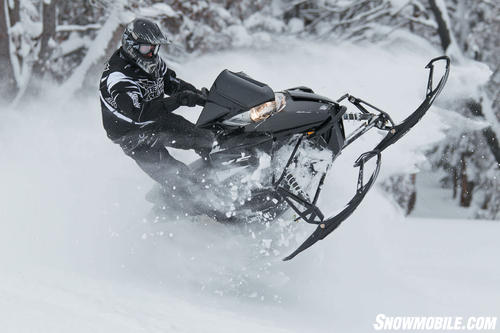
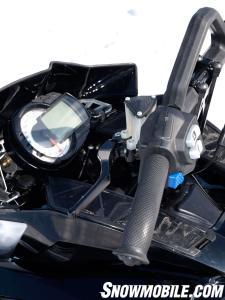
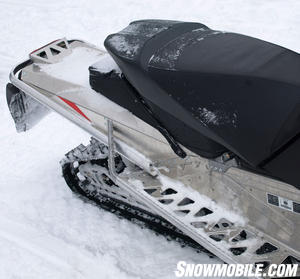
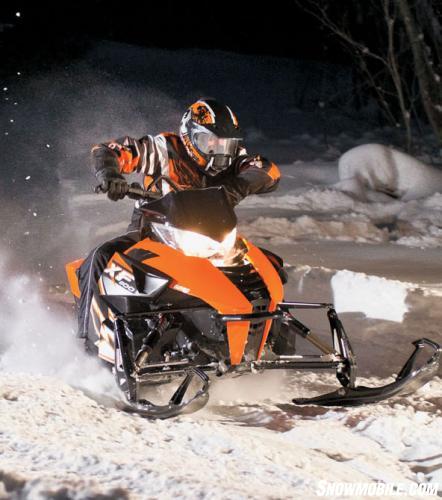
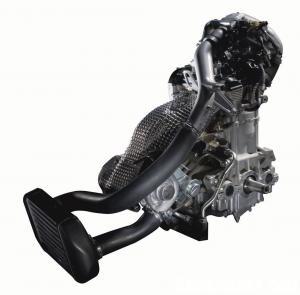
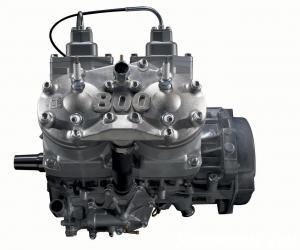

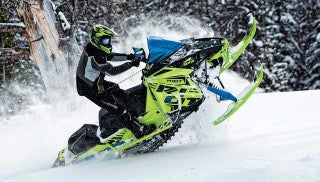



 Your Privacy Choices
Your Privacy Choices